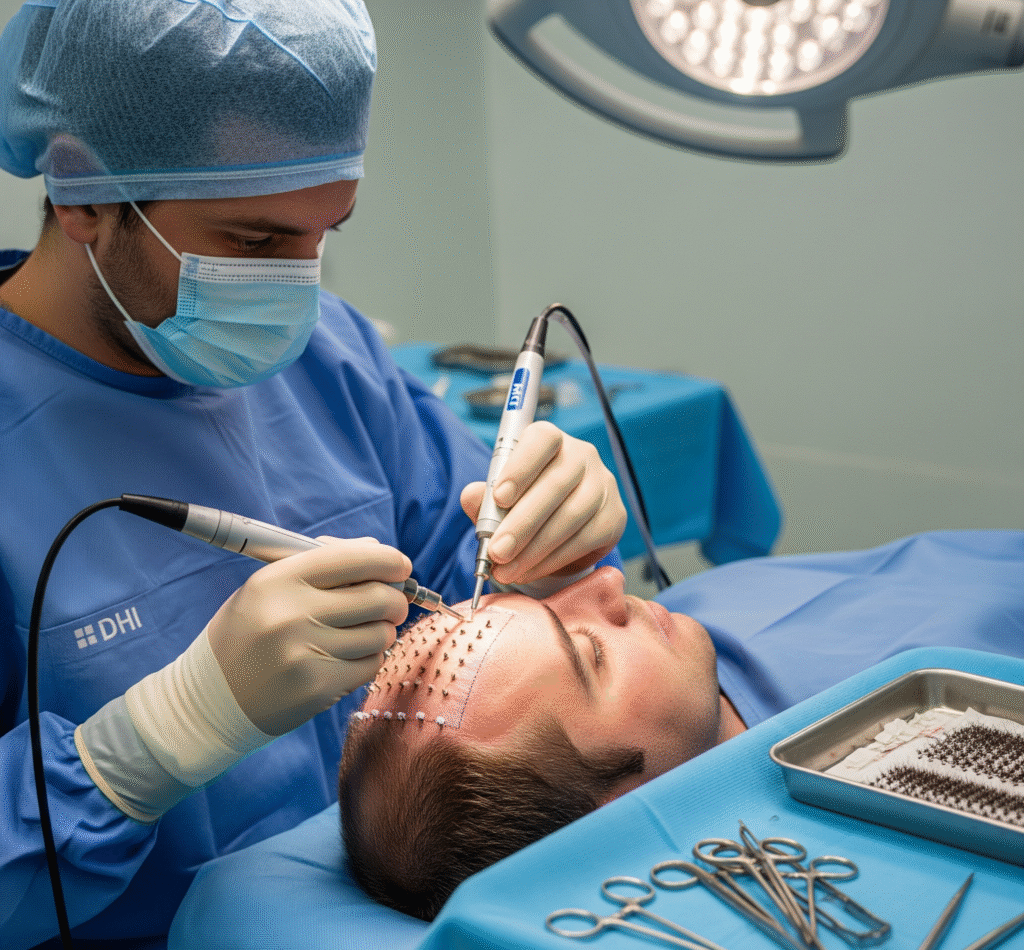Facing hair loss can be a deeply personal and often challenging experience. For many, it impacts self-esteem and confidence. Fortunately, modern medicine offers remarkable solutions, and hair transplant surgery stands at the forefront of effective hair restoration. As you explore your options, you’ll quickly encounter two leading techniques: Follicular Unit Extraction (FUE) and Direct Hair Implantation (DHI). While both can deliver transformative results, they have key differences in their approach.
Understanding the nuances in the DHI vs. FUE debate is crucial for making an informed decision that aligns with your specific needs, hair type, and desired outcome. This article will provide a clear, comprehensive comparison of these two popular methods. We will break down each procedure, compare them side-by-side, and help you understand the factors to consider when discussing your options with a specialist. Our goal is to empower you with the knowledge to confidently take the next step in your hair restoration journey.

What is Follicular Unit Extraction (FUE)? A Closer Look
Follicular Unit Extraction (FUE), revolutionized the field of hair restoration surgery by offering a less invasive alternative to older methods. It has become a gold standard for its ability to produce natural-looking results without the linear scarring associated with previous techniques. The core principle of FUE is the individual extraction of hair follicles from a donor area.
The FUE procedure typically involves these key stages:
Preparation: The surgeon will usually shave a section of the donor area, most often the back of the head, where hair is genetically resistant to balding.
Extraction: Using a specialized micro-punch tool, the surgeon carefully extracts individual follicular units (natural groupings of 1-4 hairs) one by one. These tiny extractions leave small, dot-like scars that are typically unnoticeable once the surrounding hair grows out.
Incision and Implantation: The surgical team then prepares the extracted follicles, or grafts, for placement. The surgeon makes tiny incisions in the recipient area (the area of thinning or balding) according to the planned hairline design. Finally, the grafts are carefully placed into these incisions using forceps.
FUE is highly effective for treating large areas of baldness and is a versatile technique used by skilled surgeons worldwide. The precision of the extraction and placement allows for a truly natural and dense result when performed by an experienced professional.
The DHI Method and the Choi Implanter Pen
Direct Hair Implantation (DHI) is often considered a more advanced or modified version of the FUE technique. While the extraction process is very similar to FUE, the significant difference lies in the implantation stage. The DHI method utilizes a patented, pen-shaped tool known as a Choi Implanter Pen, which streamlines the placement process.
The DHI procedure steps are what set it apart:
Extraction: As with FUE, individual hair follicles are extracted from the donor area using a micro-punch tool.
Loading the Pen: Immediately after extraction, the harvested follicles are carefully loaded into the hollow needle of the Choi Implanter Pen.
Direct Implantation: The surgeon then implants the follicle directly into the recipient area. The pen simultaneously makes the incision and places the graft in one fluid motion. This eliminates the need for creating pre-made incisions, giving the surgeon precise control over the depth, angle, and direction of each implanted hair.
By combining the channel creation and implantation steps, the DHI technique minimizes the time the grafts spend outside the body, which may contribute to a higher follicle survival rate. This level of control can be particularly advantageous for creating dense hairlines and working around existing hairs.
DHI vs. FUE: A Head-to-Head Comparison
To truly understand which method might be better for you, let’s compare them across several key factors.
Implantation Process: This is the biggest difference. FUE is a two-step process where the surgeon first creates all incisions and then places the grafts. DHI is a one-step process where the Choi pen creates the incision and places the graft simultaneously.
Graft Handling & Viability: In DHI, follicles are implanted shortly after extraction, reducing the time they are outside the body. Proponents of DHI argue this leads to a higher survival rate for the grafts. With FUE, grafts may be stored for a longer period while incisions are being made.
Shaving: Traditional FUE often requires shaving the entire donor area and sometimes the recipient area for maximum visibility and access. DHI can sometimes be performed without shaving the recipient area, allowing patients to conceal the procedure more easily during recovery. This is often referred to as an “unshaven hair transplant.”
Recovery Time: Both methods have similar recovery timelines overall. However, because DHI avoids making separate incisions, some patients may experience slightly less bleeding and faster healing in the recipient area. The FUE recovery time is still considered minimal, with most patients returning to non-strenuous activities within a few days.
Cost & Duration: DHI is a more meticulous, labor-intensive procedure that often requires a larger, more specialized medical team. Consequently, it is generally more expensive and can take longer to perform than a standard FUE procedure for the same number of grafts.
Which Hair Transplant Is Best for Me?
The decision between DHI and FUE is not about which technique is definitively “better,” but which one is better suited to your unique situation. The ideal choice depends on factors like the extent of your hair loss, the characteristics of your hair, your budget, and your surgeon’s expertise.
FUE may be a better option if: You need to cover a large area of baldness, as it is often more efficient for transplanting a higher number of grafts in a single session. It can also be a more cost-effective choice.
DHI may be preferable if: You are looking to add density to existing hair, require precise control for hairline refinement, or wish to avoid shaving the recipient area. Its potential for higher graft survival may also be a deciding factor for some.
Ultimately, the most critical factor in the success of any hair restoration surgery is not the tool, but the hand that wields it. The skill, artistry, and experience of your surgeon and their medical team will have the greatest impact on your final result, regardless of the technique used.
Conclusion
Both DHI and FUE are highly advanced and effective hair transplant techniques that have helped countless individuals regain their hair and confidence. FUE is a trusted and versatile standard, while DHI offers a refined implantation process with its own unique set of advantages, particularly regarding precision and graft handling. The best way to determine the right path for you is through a thorough consultation with a qualified hair restoration specialist. They will assess your hair loss pattern, discuss your goals, and recommend the technique that promises the most natural and satisfying outcome for you.



